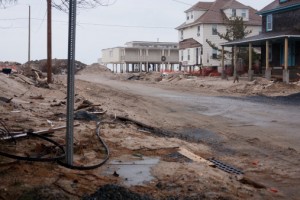
Repairing and rebuilding efforts continue in parts of the New York and New Jersey coastlines hit hardest by Hurricane Sandy more than a year ago. However, despite the gallant efforts of residents, politicians and celebrities, many of these areas are still in need of major revitalization. According to a recent article in Rolling Stone, these are the five areas where need is the greatest:
- Keansburg, New Jersey. Located in Monmouth County along Raritan Bay, residents are struggling – badly. A local food pantry continues to serve more than 2,000 people each month – with more people coming every week. According to Alyssa Durnien, a disaster case manager for Occupy Sandy New Jersey, “[H]omelessness has become a drastic problem [here]. More than 50 people are now sleeping in the Keansburg dunes. Rebuilding and recovering from this is going to take 10 to 15 years. It’s not something that happens overnight.”
- Canarsie, Brooklyn. Located in Brooklyn’s Community Board 18 Area, Canarsie’s buildings were damaged by floodwaters, forcing residents out. According to Wayne Clarke, president of the neighborhood’s Disaster Relief Committee, the area already had a serious foreclosure problem before Hurricane Sandy. The hurricane made the problem worse.
- The Rockaways, Queens. This peninsula was undoubtedly one of the most devastated in New York. According to Terri Bennett, founder of Respond and Rebuild in the Rockaways:
Low-income residents have been the hardest-hit in Sandy’s aftermath. Many displaced renters still don’t know if they’ll be able to return to their homes once their landlords rebuild. Many lower-income homeowners have been unable to qualify for disaster relief loans because they have lost their rent income.
That was really a lifeline for a lot of low-income single female heads of households. The same people who got shafted by FEMA [Federal Emergency Management Agency] are the same people who didn’t qualify for SBA [Small Business Association] loans – [and] the same people who didn’t get any or a fair insurance payout.
- Breezy Point, Queens. More than 300 families lost their homes after Hurricane Sandy – a quarter of which were lost because of waters igniting one home’s electrical system and subsequently destroying 80 others. Since Sandy, foreclosure rates in the area have increased by 60%. Insurance proceeds have been slow to make their way into the area and those home and business owners who have rebuilt or repaired have generally had to do so on their own dime.
- Red Hook, Brooklyn. The residents of Red Hook have been trying to get their community back to business for over a year. Even though many have not yet received their insurance proceeds, some took on huge debts to get things back to normal – or as close to normal as possible. Now, they say that they’re being hit with insurance premium increases of up to 15% due to their location on the Hudson River.
According to the article, other areas reportedly hit hardest by Hurricane Sandy and still in need of revitalization include Long Island, Seaside Heights, N.J., Midland Beach, Staten Island and Union Beach, New Jersey.
Belluck & Fox: Helping You Get The Insurance Proceeds You Deserve
Many of the residents in the areas listed above have yet to receive their rightful insurance proceeds to repair and rebuild. The bottom line is that insurance companies should have settled the vast majority of claims by now. More than a year has passed. However, many insurance companies have engaged in disputing settlement amounts, improperly calculating deductibles, undervaluing claims, proposing unfair settlements, denying claims and engaging in bad faith insurance practices.
If your insurance company hasn’t treated you fairly or in good faith, contact Belluck & Fox and let one of our experienced New York insurance dispute attorneys analyze your situation, get your claim settled once and for all and determine whether you might be entitled to other compensation for bad faith insurance practices.


